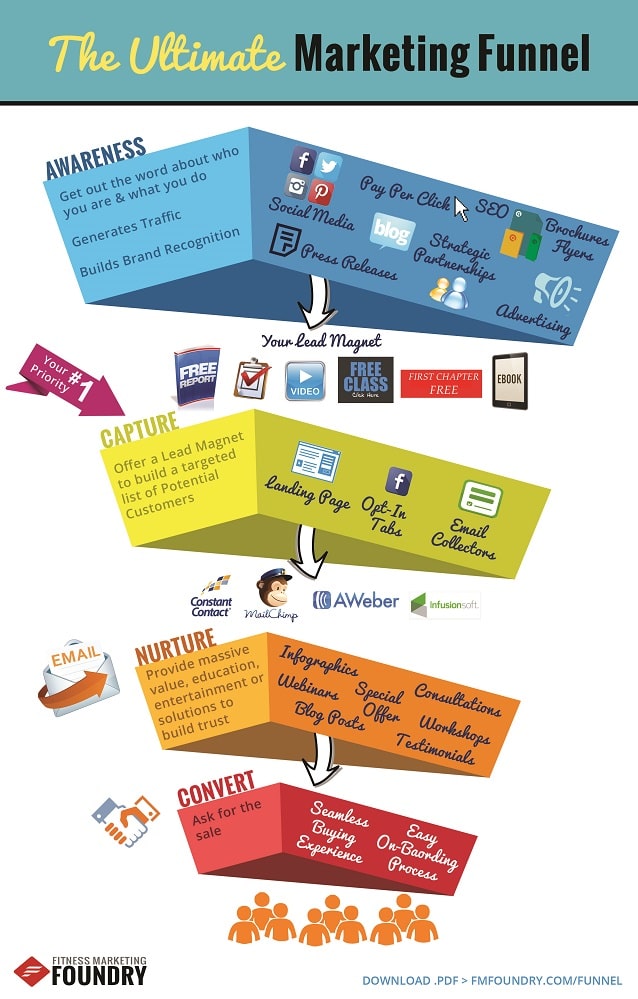The 4-Step Marketing Funnel to Attract New Clients
Discover a targeted client-attraction system that provides results.

Did you know that revenues from the personal training and small-group exercise industries were estimated at $10.2 billion in 2014 and were expected to increase by 1.6% in 2015 (IBISWorld 2015)? There is more than $10 billion up for grabs! $10,000,000,000! That's a lot of zeros. While that statistic might sound like great news, it also means that competition for personal training, boot camp and small-group exercise is fierce. However, you already knew that, didn't you? So how do you break through the noise to attract new clients?
Unfortunately, intermittent ads on Facebook or in the local newspaper no longer work. Everyone else is doing the same thing. Referrals from current clients offer the best kind of new client. However, if a referral isn't in a position to purchase your services straight away, you might not get the sale. Have you tried cross-promotions with a physical therapist or an active-clothing store? Sure, they can work, but the leads usually fizzle over time.
Each of these marketing tactics alone doesn't add up to much traffic. However, this fragmented approach is what most personal trainers adopt: They jump from marketing tactic to marketing tactic without an overall strategy.
What results is a vicious cycle: getting too few clients, dropping prices to attract new clients, feeling panicked when those bargain-hunting clients find a better deal, encountering financial stress and dropping prices even further.
A haphazard, last-minute approach to marketing like this will always lead to financial troubles. That's why you need a marketing system that will ensure a steady flow of new clients. Here's how to create one.
A Marketing Funnel
A marketing funnel is the ultimate client-attraction system; once set up, it will continually generate leads for your business. By dedicating just 30 minutes per day to your marketing funnel, you can expect dramatic results in the number of new clients registering for your programs. A marketing funnel consists of four parts:
- generating awareness about
your services - capturing contact information
- nurturingnew leads
- converting leads to clients
Setting Goals
Before creating your first marketing funnel, it is critical to understand the funnel's goal. Just as you don't create the same personal training plan for every client, you won't create the same marketing funnel system for every program you offer. You should have at least one marketing funnel for each of the products or services you provide.
For each funnel determine the following:
- Your target audience. Be very specific. Example: Females 55–65 years old, 5-mile radius of town, with middle-
class income. - The problem you are solving for your target audience. Example: Many women have arthritis, osteoporosis, back pain or prior injuries. They know they should be active to reduce pain, but they're scared of injuring themselves and don't know where to start.
- The service you're offering that will solve the problem. Example: Women on Weights: 8-Week Strengthening and Stretching program.
Now that you've determined whom your marketing funnel is for and what product you will be offering to solve the specific problem, it's time to map out the client-attraction system.
Step #1: Generate Awareness
At the top of your marketing funnel, list ways to reach your target audience. The goal in the awareness phase is to showcase that you are an expert in helping your target audience solve its problem. Define the media sources that your target audience frequents. In the example above, the trainer wants to sell the Women on Weights program. The awareness phase might include these ideas:
- Ask the local morning news show producer to do a segment on "4 Ways to Reduce the Risk of Osteoporosis."
- Post a blog article two to four times per month that solves the women's problem: arthritis-friendly exercises, stretches to reduce lower-back pain, chair yoga video, etc.
- Repurpose your blog content. Repost it on the social media channels your target audience uses most. In this case, 55- to 65-year-old females are more likely to be on Facebook than on Twitter or Snapchat.
- Create a weekly Ask the Trainer segment on your Facebook page.
- Post links to relevant articles from other reputable sources like Woman's Day and Redbook on your Facebook page.
- Write an article for your local AARP newsletter or magazine for seniors.
- Place paid ads where the target audience frequents.
- Reach out to three physicians' offices each week. Tell them about your Women on Weights program and ask if you can leave brochures in these locations.
- Offer a free Women on Weights workout every quarter at a corporate office or in your own facility.
It's not difficult to come up with ideas on how to generate awareness for your programs. What's challenging is being consistent. Pick three to five marketing tactics each week. Make it a point to complete your three to five tasks every week . . .
no matter what! This high-priority item will create a constant, sustainable source of new leads for your business.
Step #2: Capture Information
You'll spend time, energy and money on creating awareness. Now it's time to reap the rewards. We're going to move our target audience from other people's platforms (Facebook, magazines, etc.) into your world. Your primary goal in the capture phase is to build an email database of contacts. This strategy will allow you to promote your products over and over again and reduce reliance on paid advertising.
Offer a free report, free eBook or free video that helps members of your target audience solve their problem. Potential clients will enter their email address in exchange for the free resource. An email collector can be placed on multiple parts of your website—on a dedicated webpage, in a "hello" bar at the top of your website, at the bottom of every blog post, or as an "exit pop-up" when people are about to leave your site. The website SumoMe.com is a web app that accomplishes most of these tasks.
One effective way to capture information is by mentioning your free resource in the awareness phase. At the end of a news segment or magazine article, for example, mention, "Go to www.yourdomain.com/free-book to download a free '10-Minute Stretching for Arthritis Video.'"
Use an email marketing platform like MailChimp, AWeber or Constant Contact rather than Gmail or Yahoo to collect and store email addresses. These email marketing platforms will automate delivery of your free resource and provide statistics to track email marketing activities. If you're not tech-savvy, a marketing expert or web developer can easily set this up for you.
Step #3: Nurture Leads
I've never met anyone who got married on his or her first date! Similarly, most people won't buy the first time they discover your programs. You need to woo them a bit and show them why your program is worth the commitment. That's why the goal in the nurture phase is to build trust with your new leads.
Many of the same tactics you used to generate awareness are also the ones you'll use to nurture trust. Deliver snippets of solutions to your target audience's problem. Make it easy by creating content once and then distributing it across multiple platforms. Send out blog articles, client success stories, fitness tips and invitations to free workouts via social media and email newsletters. Then, when it comes time to make a sales pitch, your fans will unequivocally know you are the expert who can help them solve their problem. You've already given them a taste of the solution, and now it's time for them to dig into the main course!
If someone unsubscribes from your email list, don't worry; chances are that person wasn't a right fit for your services anyway. The people who stick around and "listen" to what you have to say will be more likely to become your customers and, eventually, become evangelists for you and your programs.
Again, consistency is the key to success. You've already spent time and money generating email leads and social media followers. Use a calendar to map out your weekly social media posts and schedule two to four emails per month. Note which days you will post your educational or entertaining content and which days you will make a sales pitch.
Step #4: Convert Leads to Clients
Don't be shy; ask for the sale. You are offering a valuable service. By providing programs like Women on Weights, you are helping people get stronger and build their confidence, and you're positively affecting their entire lives. These women will be able to move about their day with less pain and play more with their grandchildren. What a gift!
For every four to six pieces of educational or entertaining content you post on social media or via email, make a sales pitch that highlights the benefits of your program: "Women on Weights starts May 13. Sign up today to strengthen your way to a pain-free life."
Be sure you provide a seamless buying experience for the customer. Test and re-test the customer checkout process if selling online. Don't make someone click through a five-page enrollment form to purchase your program. Simplicity is best. Be proactive by giving clients step-by-step instructions on where to meet, what to bring, and other things they can expect from the program. Make them feel like a VIP from the very beginning.
A Key to Success
A marketing funnel is the ultimate client-attraction system that, when implemented with consistency, will become an integral part of your business growth. You'll discover better conversion rates and will save money by taking focused action. By implementing a marketing funnel for each of your products and target audience types, you're going to spend less time chasing the wrong clients and more time delivering great workouts to the right ones.
I am confident you can get anyone fit. However, if you shout into a room of 1 million people, "I can get you fit," no one will care. You're just another murmur in the crowd. If you shout into a room of 100 people, "I can help you lose the freshmen 15 pounds in 4 months," you're going to get more people turning their heads. You are offering a specific solution to a specific problem in a smaller space.
The lesson: Be extremely specific about the type of client you want in your program. If you're not specific, you'll be wasting time and money chasing after 1 million wrong people, when you really only need to reach 100 right people.
References
IBISWorld 2015. Personal trainers in the US: Market research report. Accessed Jan. 20, 2016. www.ibisworld.com/industry/personal–trainers.html.
Jill Tomich
Jill's passion is helping folks feel fabulous and confident about their bodies. Whether working with clients one-on-one in a confidential environment or motivating the masses in boot camp classes or blog entries, her positive coaching style always leads to one thing: results.
Results-Driven Fitness:
Inspired to create a fitness program that focused on results, Jill introduced Ultimate Bootcamp (www.ultimatebootcamp.com) outdoor workouts to the Boston area with a BANG! These fun-filled, fast-paced, progressive workouts were designed so that both the fitness novice and athlete can push their boundaries. To date, Jill and her elite team of Ultimate Bootcamp Trainers have helped over 6,000 New Englanders get in shape.
Wedding Gown Workouts:
After coaching many brides-to-be to their wedding gown WOW moment, Jill launched Bombshell Bride (www.bombshell-bride.com) to bring her expertise to a wider audience. The wedding diet and fitness website focuses on hel




